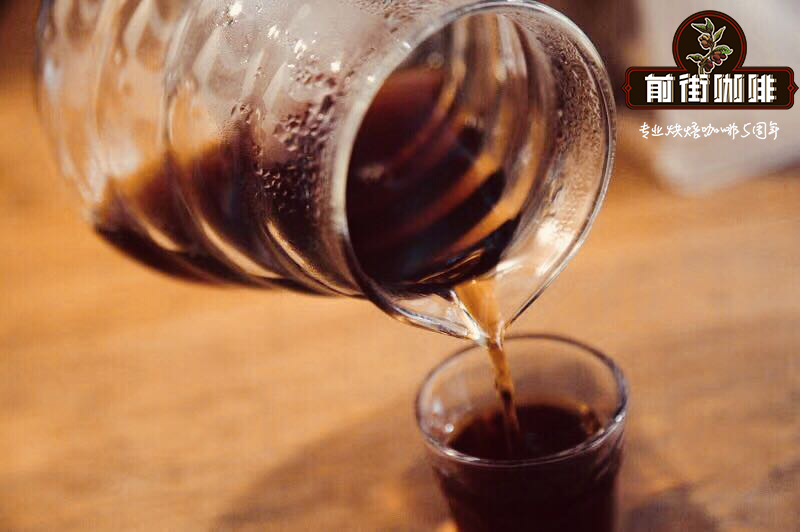The advantages of hand-brewed coffee are not only convenient and quick to taste coffee methods and steps for beginners' advanced guide

Professional coffee knowledge exchange more coffee bean information please follow the coffee workshop (Wechat official account cafe_style)
Qianjie-introduction to hand-made coffee and coffee tasting guide
Individual coffee can be traced back to the origin of coffee, not only the producing country of coffee, but even the land where coffee is produced. By knowing the owner of the coffee farm, going deep into the origin of coffee, understanding the story of the origin of coffee from the source, and purchasing raw beans. Hand-brewed coffee is not only fast and convenient, but also can taste the different flavors of different producing areas.
Coffee tasting
1. Smell fragrance
Dry aroma: put freshly ground coffee powder close to your mouth and nose, and you will feel the dry aroma of different coffees from different coffee producing areas. For example, in Latin American coffee, you will smell something similar to nuts and dark chocolate, while coffee in Africa has more floral and fruit flavors.
Wet fragrance: pour the coffee into the cup, close your eyes and slowly smell its wet fragrance. You may smell nutty, chocolate, fruity or floral aromas.
Another major misunderstanding of human beings when tasting food is that the tongue cannot actually distinguish the smell, and only when the aroma of the food enters the nasal cavity can you fully perceive the taste of the food.
Inferior quality: industrial flavor, rotten smell, earthy taste, etc.
Quality: the aroma of coffee contains rich aromas such as wine, flowers and fruit, no matter the dry aroma of coffee powder or the wet fragrance after brewing, will bring you a sense of smell to enjoy.
two。 Taste: when coffee is in your mouth, you can feel its flavor. In this respect, many enthusiasts, especially those who are just beginning to come into contact with coffee tasting, always think that coffee doesn't smell good. It is true that the sensory discrimination of coffee liquid in the mouth requires a certain amount of exercise, but over time, the flavor can be detected.
Another key point of tasting coffee is how to distinguish between sweet, salty, sour and bitter coffee.
Mellowness is what we usually call boby, which refers to the round, mellow and strong taste of the coffee liquid. The difference between a cup of water and a cup of coffee is that water is tasteless and not sticky, while espresso is rich in oil and has a good thickness. A cup of coffee with a good mellow thickness will make the aroma stay in the mouth longer and the finish longer.
Mellow feeling will not only affect your overall coffee experience, but also affect the integrity of the release of aromatic substances in coffee. Most cup testers or consumers can't tell which tastes are good and which are bad, but at least you know what you like and what you don't like. In my opinion, the judgment of the mellow taste of coffee varies from person to person.
[sweet]
Poor quality: balsam pear, too bitter
High quality: sweet, similar to sucrose, brown sugar, caramel, mouth full of feeling
Traits: coffee with sweetness is like a kind of fruit, which contains fructose in coffee beans, even if it is a cup of black coffee, there must be sweet taste behind the sour or bitter taste. In addition, according to the difference of coffee beans, there are different levels of coffee, there is no good or bad, only depends on personal preferences. But if the taste of Huigan is too dry, it means the quality of coffee beans is not good.
[cleanliness]
Poor quality: miscellaneous flavor
Excellent quality: pure and fresh taste
Traits: in fact, the astringency of coffee does not need to be eliminated, but needs to be suppressed, and the degree of inhibition is also different according to everyone's different preferences. The taste that is more messy or has bad negative taste is not enough to achieve net.
[bitter]
Poor quality: bitter at the root of the tongue, rough "bitter"
Excellent quality: as bitter as dark chocolate
Traits: there is no simple "bitter" in boutique coffee. Generally, we will use "bitter" to describe the nutty taste, dark chocolate flavor and caramel flavor.
[acid]
Inferior quality: humic acid, sharp acid, high acidity, smack lips, acetic acid
Quality: fruit acid, fresh acid, round acid, soft acid
Traits: "Sweet is easy, good sour is rare". The sour taste of high-quality coffee should be contained in the coffee, not obvious and sharp. High-quality coffee often contains a lot of organic acid substances, such as citrus, berries and other rich sour taste, the quality of acid is an important factor in fine coffee.
[salty]
Traits: in fact, there are many kinds of salty taste, and the aroma reminds people of salty food, such as the smell of too much salt in fried vegetables, and the smell at the bottom of the cup after drinking coffee, which smells salty. Think of salty snacks such as shrimp sticks and Wangxian shellfish, and so on. And the taste summed up is the taste of salt.
Usually do hand flushing and Italian style will occasionally taste and "smell" to [salty] (smell refers to the smell after grinding), and most of the time, the salty taste is more obvious in Espresso.
Due to the distribution of taste, sour and salty taste, it is easy to be confused, inferior acid and salty taste is difficult to distinguish. But it is different from the salty taste of salt after all. Of course, some beans have an unusually salty taste, which is very close to the salty taste of sea salt.
3. Perceptual aftertaste
The last point of tasting is Huigan. The so-called Huigan refers to the aftertaste of coffee in the mouth and throat. After drinking the coffee, there will always be a taste back from the throat, some of the aftertaste is very long and clear, some are very short and very vague. We say that a longer and clearer aftertaste is good, and the quality of raw coffee beans is higher.
There is no negative taste in the whole process of a cup of coffee from smelling fragrance to drinking it, such as unclean, astringent and fermented taste. if there is such a taste, we think that this kind of coffee is unclean and must not become a boutique coffee. Many friends hope to have a breakthrough in the cup as soon as possible, but the core task of this breakthrough is to find and grasp the negative taste.
Knowledge: coffee beans contain a variety of organic compounds after roasting, especially acidic fats and volatile fats.
In short: Qianjie is a coffee research hall, happy to share the knowledge about coffee with you, we share unreservedly just to make more friends fall in love with coffee, and there will be three low-discount coffee activities every month. The reason is that Qianjie wants to make more friends drink the best coffee at the lowest price, which has been Qianjie's tenet for 6 years!
END
Important Notice :
前街咖啡 FrontStreet Coffee has moved to new addredd:
FrontStreet Coffee Address: 315,Donghua East Road,GuangZhou
Tel:020 38364473
- Prev

Which tastes better, hand-brewed coffee or espresso? how to taste coffee? learn the steps clearly.
Professional coffee knowledge exchange more coffee bean information please follow the coffee workshop (Wechat official account cafe_style) front street-hand-brewed coffee, coffee tasting introduction Italian and hand-brewed the most fundamental difference lies in the extraction method. Espresso: extraction principle: rapid stamping of coffee powder extract with hot water at 90-94 degrees Celsius at 9 atmospheric pressure
- Next

What are the characteristics of hand-brewed coffee? the four steps of tasting coffee learn one more step and one more point of pride.
Professional coffee knowledge exchange more coffee bean information please follow the coffee workshop (Wechat official account cafe_style) front street-hand-brewed coffee, coffee tasting introduction hand-brewed coffee, is the representative of the third wave of coffee aesthetics in the three waves of evolution of boutique coffee. 19401960, instant coffee, rotten coffee is the way. The second wave, 1966 Murray 2000, coffee boutique, re-baked lattes are popular.
Related
- Beginners will see the "Coffee pull flower" guide!
- What is the difference between ice blog purified milk and ordinary milk coffee?
- Why is the Philippines the largest producer of crops in Liberia?
- For coffee extraction, should the fine powder be retained?
- How does extracted espresso fill pressed powder? How much strength does it take to press the powder?
- How to make jasmine cold extract coffee? Is the jasmine + latte good?
- Will this little toy really make the coffee taste better? How does Lily Drip affect coffee extraction?
- Will the action of slapping the filter cup also affect coffee extraction?
- What's the difference between powder-to-water ratio and powder-to-liquid ratio?
- What is the Ethiopian local species? What does it have to do with Heirloom native species?

